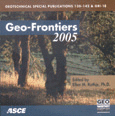Behaviour of Capillary Barrier System Constructed using Residual Soil
Publication: Waste Containment and Remediation
Abstract
Capillary barrier systems constructed using non-cohesive soil as the fine-grained layer have been studied extensively. However, capillary barrier systems constructed using a cohesive soil have not been fully studied. In this study, a capillary barrier model consisting of residual soil as the fine-grained layer and gravelly sand as the coarse-grained layer was constructed in an infiltration box apparatus. To study its performance as a water barrier for slope stabilization purpose, the capillary barrier model was subjected to several infiltration and evaporation processes. Tensiometers for the measurement of pore-water pressures, time domain reflectometry (TDR) for the measurement of volumetric water content and weighing balances for the measurement of water balance, were used in the experiment. Simulated rainfall and evaporative flux were applied to the capillary barrier model using a rainfall simulator and evaporation simulators, respectively. From the experimental results, it was found that the recovery of water storage of the capillary barrier model constructed using residual soil was very slow during the evaporation process under laboratory ambient conditions. Previous study showed that recovery of water storage is an important design variable for capillary barrier system that functions under high precipitation rates. In this study, additional evaporative flux using fan was applied to the capillary barrier model in order to simulate evaporation process in the field. It should be noted that the measured potential evaporation in the capillary barrier model due to the application of the fan was less than the potential evaporation in Singapore. The experimental results showed that capillary barrier effect existed in the capillary barrier model constructed using residual soil as the fine-grained layer. The recovery of water storage of the capillary barrier model can be accelerated using additional evaporation simulator so that the capillary barrier system can effectively function under high precipitation rates.
Get full access to this chapter
View all available purchase options and get full access to this chapter.
Information & Authors
Information
Published In
Copyright
© 2005 American Society of Civil Engineers.
History
Published online: May 7, 2012
ASCE Technical Topics:
- Engineering fundamentals
- Evaporation
- Fine-grained soils
- Geomechanics
- Geotechnical engineering
- Hydrologic engineering
- Measurement (by type)
- Models (by type)
- Pressure measurement
- Residual soils
- Simulation models
- Soil mechanics
- Soil properties
- Soils (by type)
- Volume measurement
- Water and water resources
- Water management
- Water storage
- Water supply
- Water supply systems
Authors
Metrics & Citations
Metrics
Citations
Download citation
If you have the appropriate software installed, you can download article citation data to the citation manager of your choice. Simply select your manager software from the list below and click Download.
